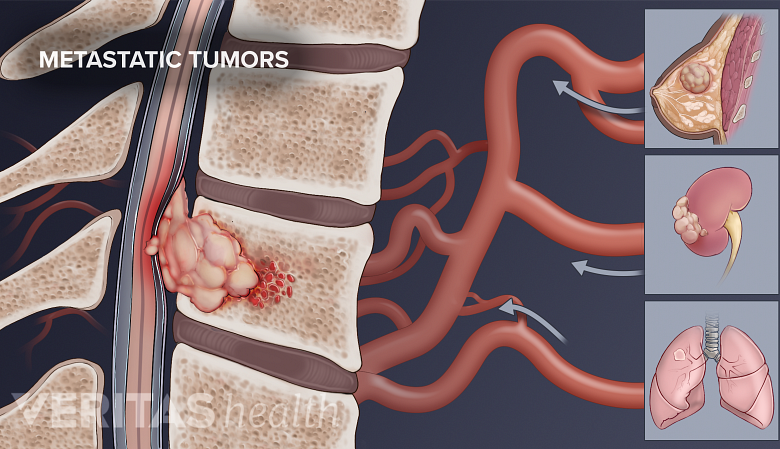A spinal tumor is an abnormal growth of tissue found in the spinal column. When a tumor spreads to the spine from cancer elsewhere in the body, it is called a metastatic spinal tumor (secondary tumor). These tumors may also be referred to as spinal metastases.
Most metastatic spinal tumors are found in the vertebrae (bones of the spinal column). Rarely, they may grow in the spinal cord or its protective covering (dura). While the first symptom of a metastatic spinal tumor is typically back pain, not all metastatic spinal tumors are symptomatic.
In This Article:
Metastatic Spinal Tumors of the Bone
Metastatic spinal cord tumors originate elsewhere in the body and spread to the spine.
The most common regions of the body for cancer cells to metastasize, or spread to, include the kidneys, lungs, and bones. When cancer spreads to a bone, it is typically one or more of the vertebrae because of the spine’s extensive venous network.
Cancer cells typically reach the spine via the bloodstream, after which they enter the bone marrow and begin to multiply. Tumors within the vertebrae can weaken the bone, eventually causing them to fracture. A fracture can cause severe pain, spinal instability, and seriously affect the patient’s quality of life.
See Vertebral Fracture Symptoms
Range of Symptoms and Signs
Back pain caused by a metastatic spinal tumor may be a deep ache felt in the spine or could sometimes radiate into the leg, chest, or elsewhere in the body, depending on the location of the tumor. If the spinal cord or any spinal nerves become compressed or damaged, neurological deficits could develop, such as numbness or weakness that affects the arms, legs, or trunk. In extreme cases, paralysis may occur.
The Course of a Metastatic Spinal Tumor
People who are over age 50, or have a previous history of cancer, are more likely to develop a metastatic spinal tumor. An untreated metastatic spinal tumor is likely to keep growing and could become life-threatening.
Treating a metastatic spinal tumor depends on many factors, including the patient’s overall health and life expectancy. There is better prognosis (long-term outlook) when treatments can preserve neurological function, such as the ability to walk. 1 Vailant B, Loghin M. Treatment of spinal cord tumors. Curr Treat Options Neurol. 2009;11(4):315-24. doi: 10.1007/s11940-009-0035-3
Metastatic spinal tumor treatment options may include radiation therapy, chemotherapy, immunotherapy, and/or surgery. In cases of advanced cancer or when the patient is unlikely to tolerate surgery well, palliative care is typically recommended. Palliative care focuses on reducing pain and living comfortably rather than curing or removing the tumor(s).
See Treatments for Spinal Tumors
Where Metastatic Spinal Tumors Occur
Approximately 70% of metastatic spinal tumors are found in the thoracic region.
Spinal tumors can occur anywhere along the spine, but most occur in the thoracic (mid-to-upper back) region 2 Ziu E, Mesfin FB. Cancer, Spinal Metastasis. [Updated 2019 Apr 23]. In: StatPearls [Internet]. Treasure Island (FL): StatPearls Publishing; 2019 Jan-. Available from: https://www.ncbi.nlm.nih.gov/books/NBK441950/ :
- About 70% of metastatic spinal tumors occur in the thoracic region
- About 20% occur in the lumbar (lower back) region
- Fewer occur in the cervical (neck) region
It is also possible for metastatic spinal tumors to occur in multiple regions of the spine at the same time. About 90% of diagnosed spinal tumors are metastatic spinal tumors. 2 Ziu E, Mesfin FB. Cancer, Spinal Metastasis. [Updated 2019 Apr 23]. In: StatPearls [Internet]. Treasure Island (FL): StatPearls Publishing; 2019 Jan-. Available from: https://www.ncbi.nlm.nih.gov/books/NBK441950/ , 3 Ciftdemir M, Kaya M, Yalniz E, et al. Tumors of the spine. World J Orthop. 2016;7(2):109-16.
When to See a Doctor
Anyone with cancer or a history of cancer should call the physician if back pain occurs slowly, the onset of pain is sudden, and/or if an existing back pain becomes worse.
Cancer patients who develop new signs and symptoms, especially the ones that involve a neurological component (for example, loss of bowel or bladder control, loss of muscle function or weakness), or radiating pain (that travels into the arm or leg), must seek immediate medical attention.
- 1 Vailant B, Loghin M. Treatment of spinal cord tumors. Curr Treat Options Neurol. 2009;11(4):315-24. doi: 10.1007/s11940-009-0035-3
- 2 Ziu E, Mesfin FB. Cancer, Spinal Metastasis. [Updated 2019 Apr 23]. In: StatPearls [Internet]. Treasure Island (FL): StatPearls Publishing; 2019 Jan-. Available from: https://www.ncbi.nlm.nih.gov/books/NBK441950/
- 3 Ciftdemir M, Kaya M, Yalniz E, et al. Tumors of the spine. World J Orthop. 2016;7(2):109-16.













